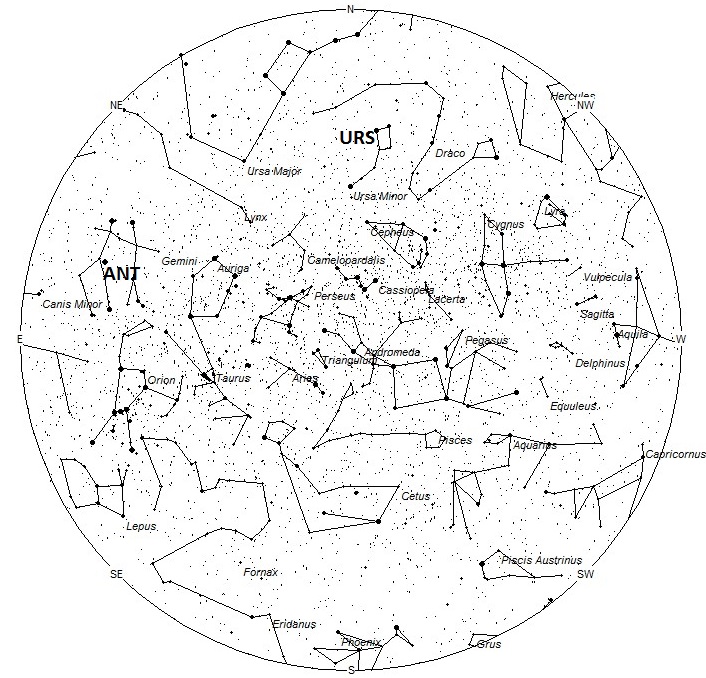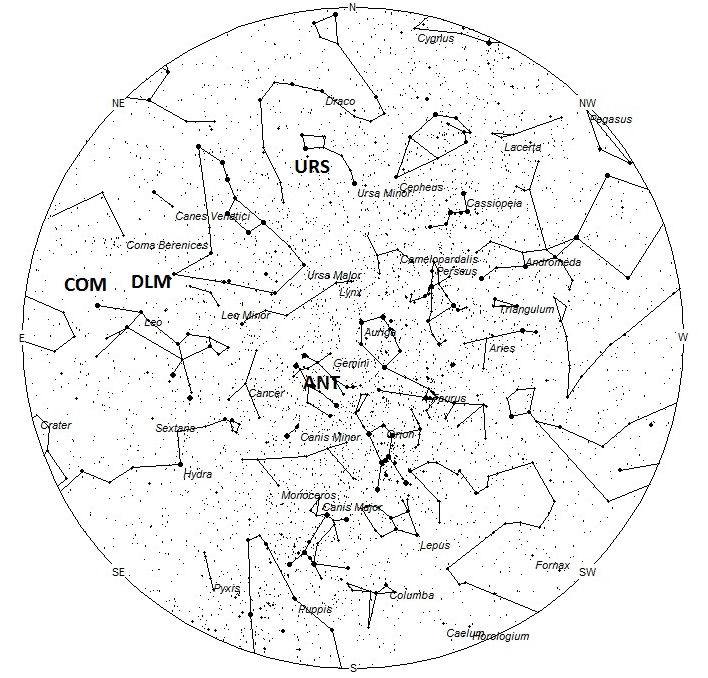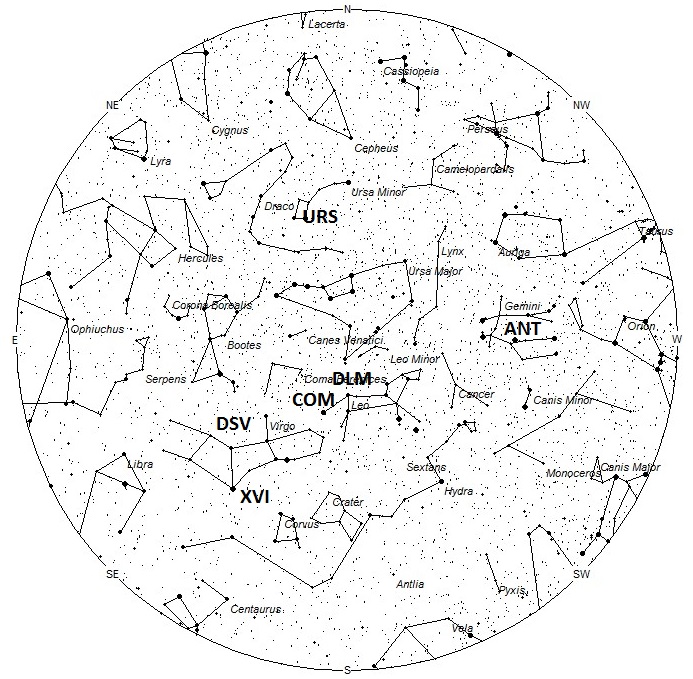During this period the moon reaches its last quarter phase on Wednesday December 25th. At this time the moon will lie 90 degrees west of the sun and will rise near midnight local standard time (LST). This weekend the waning gibbous moon will rise during the evening hours and will greatly interfere with any attempt at viewing meteor activity during the remainder of the night. As the Christmas holiday passes the moon becomes less of a nuisance and successful observations may be obtained. The estimated total hourly meteor rates for evening observers this week is near 3 for observers located in the northern hemisphere and 2 for those viewing south of the equator. For morning observers the estimated total hourly rates should be near 13 for observers in the northern hemisphere and 5 for observers situated south of the equator. Morning rates are reduced during this period due to moonlight. The actual rates will also depend on factors such as personal light and motion perception, local weather conditions, alertness and experience in watching meteor activity. Note that the hourly rates listed below are estimates as viewed from dark sky sites away from urban light sources. Observers viewing from urban areas will see less activity as only the brightest meteors will be visible from such locations.
The radiant (the area of the sky where meteors appear to shoot from) positions and rates listed below are exact for Saturday night/Sunday morning December 21/22. These positions do not change greatly day to day so the listed coordinates may be used during this entire period. Most star atlases (available at science stores and planetariums) will provide maps with grid lines of the celestial coordinates so that you may find out exactly where these positions are located in the sky. A planisphere or computer planetarium program is also useful in showing the sky at any time of night on any date of the year. Activity from each radiant is best seen when it is positioned highest in the sky, either due north or south along the meridian, depending on your latitude. It must be remembered that meteor activity is rarely seen at the radiant position. Rather they shoot outwards from the radiant so it is best to center your field of view so that the radiant lies at the edge and not the center. Viewing there will allow you to easily trace the path of each meteor back to the radiant (if it is a shower member) or in another direction if it is a sporadic. Meteor activity is not seen from radiants that are located below the horizon. The positions below are listed in a west to east manner in order of right ascension (celestial longitude). The positions listed first are located further west therefore are accessible earlier in the night while those listed further down the list rise later in the night.
The following sources of meteoric activity are expected to be active this week:
Now that the activity from particles produced by comet 2P/Encke has ceased encountering the Earth, the Taurid showers for 2012 are over and we resume reporting activity from the Anthelion (ANT) radiant. This is not a true radiant but rather activity caused by the Earth’s motion through space. As the Earth revolves around the sun it encounters particles orbiting in a pro-grade motion that are approaching their perihelion point. They all appear to be radiating from an area near the opposition point of the sun, hence the name (Anti)helion. These were once recorded as separate showers throughout the year but it is now suggested to bin them into their category separate from true showers and sporadics. This radiant is a very large oval some thirty degrees wide by fifteen degrees high. Activity from this radiant can appear from more than one constellation. The position listed here is for the center of the radiant which is currently located at 06:52 (103) +23. This position lies in central Gemini, 3 degrees southeast of the third magnitude star Mebsuta (Epsilon Geminorum). Anthelion activity may also appear from eastern Taurus, northeastern Orion, Cancer, Canis Minor, Monoceros, or southern Auriga. This radiant is best placed near midnight local standard time (LST) when it lies on the meridian and is highest in the sky. Rates at this time should be near 1 per hour as seen from the northern hemisphere and less than 1 per hour from south of the equator. With an entry velocity of 30 km/sec., the average Antihelion meteor would be of slow velocity.
The December Leonis Minorids (DLM) are active from a radiant located at 10:52 (163) +30. This position lies in central Leo Minor, approximately four degrees southwest of the third magnitude star Alula Borealis (Nu Ursae Majoris). These meteors are best seen near 0400 LST when the radiant lies highest above the horizon. This shower peaked on December 17th so current rates would be near 1 per hour as seen from the northern hemisphere and less than 1 per hour as seen from south of the equator. At 64 km/sec. the December Leonis Minorids produce mostly swift meteors.
The Coma Berenicids (COM) are best seen from December 23 through January 2. Maximum activity occurs on December 30 when this shower is the fourth strongest in the sky. The current radiant position lies at 12:08 (182) +17. This position lies western Coma Berenices, 5 degrees northwest of the second magnitude star Denebola (Beta Leonis). Current hourly rates would most likely be less than one shower member per hour no matter your location. These meteors are best seen during the last dark hour before dawn, when the radiant lies highest above the horizon in a dark sky. At 69 km/sec. The Coma Berenicids would produce mostly swift meteors.
The December Chi Virginids (XVI) was discovered by Japanese observers using the data of SonotaCo. This source is active from December 16-14 with maximum activity occurring on the 18th . The current radiant location is at 13:04 (196) -12, which places it in southern Virgo, 4 degrees southwest of the bright 1st magnitude star known as Spica (Alpha Virginis). Current rates would most likely be less than one shower member no matter you location. These meteors are best seen during the last dark hour before dawn, when the radiant lies highest above the horizon in a dark sky. At 70 km/sec. the December Chi Virginids would produce mostly swift meteors.
The December Sigma Virginids (DSV) was discovered by John Greaves using the data of SonotaCo. IMO video cameras confirmed that this source is active during most of December and into the first week of January. Visual observers have their best chance at catching these meteors from December 17 through January 1st. Peak rates occur near December 25th. The current radiant location is at 13:48 (207) +04 which place it in northern Virgo some 3 degrees northwest of the fourth magnitude star Tau Virginis. Current hourly rates would near 1 shower member no matter you location. These meteors are best seen during the last dark hour before dawn, when the radiant lies highest above the horizon in a dark sky. At 69 km/sec. the December Sigma Virginids would produce mostly swift meteors.
The Ursids (URS) peak on the morning of December 22 from a radiant located at 14:32 (218) +75. This position lies in eastern Ursa Minor, just northeast of the second magnitude star Kochab (Beta Ursa Minoris). These meteors are best seen during the last dark hour before dawn, when the radiant lies highest above the horizon in a dark sky. Due to the extreme northerly location meteors from this shower are not visible from the southern hemisphere. On the morning of maximum, hourly rates of between 3-5 Ursids may be seen during the late morning hours. Away from maximum, hourly rates would be only 1 or less. At 33 km/sec. the Ursids produce mostly medium-slow meteors.
As seen from the mid-northern hemisphere (45N) one would expect to see approximately 6 sporadic meteors per hour during the last hour before dawn as seen from rural observing sites. Evening rates would be near 3 per hour. As seen from the tropical southern latitudes (25S), morning rates would be near 4 per hour as seen from rural observing sites and 2 per hour during the evening hours. Locations between these two extremes would see activity between the listed figures. Morning rates are lower during this period due to moonlight.
The table below presents a list of radiants that are expected to be active this week. Rates and positions are exact for Saturday night/Sunday morning except where noted in the shower descriptions.
| SHOWER | DATE OF MAXIMUM ACTIVITY | CELESTIAL POSITION | ENTRY VELOCITY | CULMINATION | HOURLY RATE | CLASS |
| RA (RA in Deg.) DEC | Km/Sec | Local Standard Time | North-South | |||
| Anthelions (ANT) | – | 06:52 (103) +23 | 29 | 00:00 | 1 – <1 | II |
| Dec. Leonis Minorids (DLM) | Dec 17 | 10:52 (163) +30 | 64 | 04:00 | 1 – <1 | II |
| Coma Berenicids (COM) | Dec 17 | 12:08 (182) +17 | 69 | 05:00 | <1 – <1 | II |
| Dec. Chi Virginids (XVI) | Dec 18 | 13:04 (196) -12 | 70 | 06:00 | <1 – <1 | IV |
| Dec. Sigma Virginids (DSV) | Dec 25 | 13:48 (207) +04 | 69 | 07:00 | 1 – 1 | IV |
| Ursids (URS) | Dec 22 | 14:32 (218) +75 | 33 | 08:00 | 4 – <1 | I |
 American Meteor Society
American Meteor Society



In Prescott AZ at 630 pm I saw a large meteor with a long tail. It occored on dec. 26 . Me and two other people saw it. We were facing north and it was low on the horizon heading from the east to the west. It grew brighter as it went through the sky and was different colors mostly white and red
On Dec. 24th 2013 I was driving west on highway 33 east of Guthrie, Okla., at about 5:30 p.m. I saw a light blue meteor with two oval shapes, one slightly ahead of the other, and one slender tail. It came from my right at about the 3:00 position, and lasted about 3 seconds.
On Dec. 27, 2013, while driving W on 494 outside of Mpls, I saw a very large and very low meteor in the north sky. It was so low it appeared it would hit one of the taller buildings on the side of the road, but in fact burned out before. It was very bright white, with quite a long tail and was moving westward. It seemed so close my heart was pounding as I saw it, thinking it was going to crash into something on or near the ground. Very exciting!